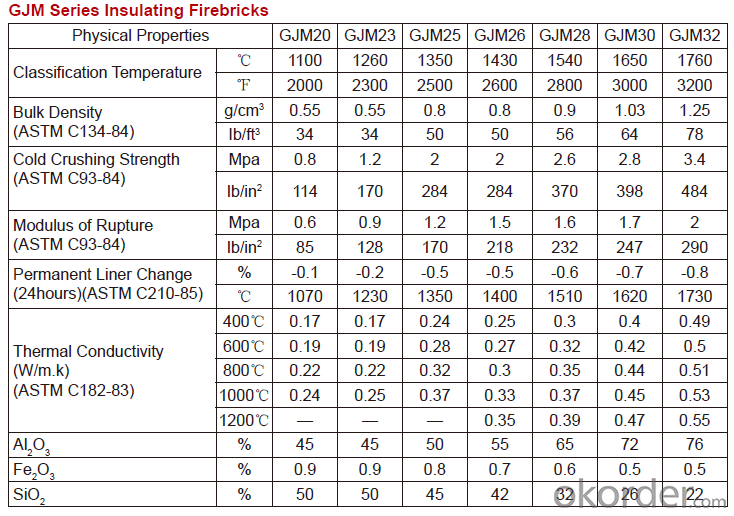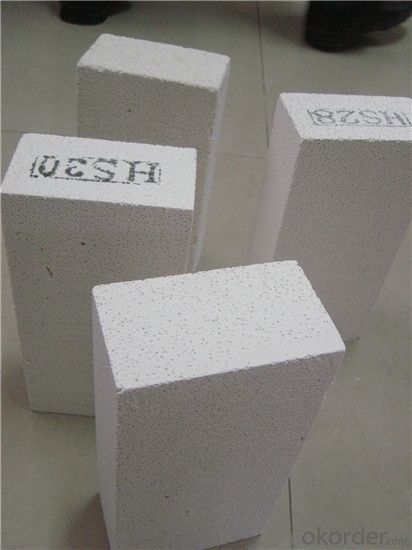Light Dense Mullite Insulation Brick Product
- Loading Port:
- Shanghai
- Payment Terms:
- TT OR LC
- Min Order Qty:
- 1 m.t.
- Supply Capability:
- 10000 m.t./month
OKorder Service Pledge
OKorder Financial Service
You Might Also Like
Thermal Insulation Fire Clay Brick
Refractory brick is a refractory material used in lining furnaces, kilns, fireboxes, and fireplaces.
We provide high quality Refractory Fire Bricks that are used on wide range in the various industries like Cement, Glass and Steel. Refractory Fire Bricks are provided as per the quantity and specifications required by the customers. We provide an extensive range of Refractory Fire Bricks at reasonable prices that depend upon the quantity ordered.
Application
Insulating Fire Brick are used for the lining of converter, alternating current arc furnace, direct Current arc furnace and the ladle slag line, etc.
Company Advantage
(1)Long Insulating Fire Brick manufacture history: 25 years manufacturer
(2)Advanced equipment and good service
(3)Diversification of production standards: ISO ANSI FEPA JIS ASTM
(4)Flexible payment: T/T L/C D/P D/A
(5)Professional marketing team and after-sale service
Insulating Fire Brick main feature:

Equipment
1 unit of Ceramic Abrasive (SG Abrasive) pilot production line
2 units of Compact grain Abrasive pilot production lines
1 unit of high-end coated abrasives (abrasive cloth) production line
3 large flexible crushing and sieving lines for grit production lines
6 units of 5000KVA-10000KVA dumping type electric arc furnaces for Brown Fused Alumina fusion
FAQs
Q1 What’s the transport method?
A1 FCL delivery goods with wooden pallet or wooden case by sea; If LCL delivery, must with wooden case; Sometimes need open top, flat rack or bulk cargo.
Q2 What’s the required payment term?
A2 Generally 30% TT as the prepayment, 70% TT before delivery. If need, 100% Irrevocable Letter of Credit or negotiation.
Q3 Which country are our products exported to?
A3 Apart from entire Chinese market, the US, Russia, Japan, Korea, Australia and some Southeast Asian Nations.


- Q:Are insulating fire bricks resistant to thermal conductivity?
- Yes, insulating fire bricks are designed to be resistant to thermal conductivity. These bricks are made from materials with low thermal conductivity, such as lightweight refractory fibers or insulating materials like vermiculite or perlite. The purpose of insulating fire bricks is to provide thermal insulation and prevent heat transfer, making them ideal for applications where temperature control is important, such as in kilns, furnaces, or fireplaces. By reducing thermal conductivity, insulating fire bricks help to retain heat within the desired area and minimize energy loss, making them an effective choice for insulation in high-temperature environments.
- Q:Do insulating fire bricks require special handling?
- Special handling is necessary for insulating fire bricks. These bricks are manufactured using lightweight refractory materials and are specifically engineered to endure high temperatures. Because they are delicate, they must be treated carefully to avoid any breakage or harm. It is advised to employ appropriate lifting and carrying methods, including the use of gloves and tongs or lifters, in order to prevent accidents or injuries. Moreover, it is crucial to store insulating fire bricks in a dry and sheltered location to prevent moisture absorption, which can impact their thermal characteristics.
- Q:Can insulating fire bricks be painted or coated?
- Insulating fire bricks are specifically designed to withstand high temperatures and provide effective thermal insulation. While it is technically possible to paint or coat them, it is generally not recommended. The reason for this is that the paint or coating may not be able to withstand the extreme temperatures that the fire bricks are exposed to, and as a result, it may deteriorate or even potentially become a fire hazard. Additionally, painting or coating the fire bricks may reduce their insulating properties, defeating the purpose of using them in the first place. Therefore, it is advisable to use insulating fire bricks as they are, without any additional paint or coating.
- Q:Do insulating fire bricks have good insulation performance at high temperatures?
- Yes, insulating fire bricks have excellent insulation performance at high temperatures. These bricks are designed specifically to withstand extremely high temperatures and provide a high level of thermal insulation. They are made from lightweight materials that have low thermal conductivity, allowing them to effectively trap and contain heat within a furnace, kiln, or other high-temperature applications. This insulation property helps in reducing heat loss and maintaining a consistent temperature inside the structure. Insulating fire bricks are widely used in industries such as ceramics, metallurgy, glass-making, and heat treatment, where maintaining high temperatures and thermal efficiency are crucial.
- Q:Are insulating fire bricks resistant to thermal expansion or contraction?
- Yes, insulating fire bricks are resistant to thermal expansion and contraction. These bricks are made of materials that have low thermal conductivity, allowing them to withstand high temperatures without undergoing significant expansion or contraction. This property makes them ideal for applications where thermal stability and insulation are required, such as in kilns, furnaces, and other high-temperature environments.
- Q:What are the advantages of using insulating fire bricks over traditional bricks?
- There are several advantages of using insulating fire bricks over traditional bricks. Firstly, insulating fire bricks have significantly better thermal insulation properties compared to traditional bricks. This means that they are able to retain heat more efficiently and prevent heat loss. This makes them ideal for applications where temperature control is essential, such as in industrial furnaces, kilns, and ovens. By reducing heat loss, insulating fire bricks can help to improve energy efficiency and reduce heating costs. Secondly, insulating fire bricks have a higher melting point than traditional bricks, making them more resistant to high temperatures. This makes them suitable for use in environments with extreme heat, such as in metallurgical and glass industries. Insulating fire bricks can withstand temperatures up to 3000°F (1650°C), whereas traditional bricks typically have a lower melting point. Furthermore, insulating fire bricks are lightweight and have a low thermal mass. This means that they heat up quickly and cool down rapidly, making them suitable for applications that require frequent temperature changes or quick heat-up times. Traditional bricks, on the other hand, have a higher thermal mass and take longer to heat up or cool down. Additionally, insulating fire bricks are more resistant to thermal shock and can withstand rapid temperature changes without cracking or breaking. This makes them more durable and long-lasting compared to traditional bricks, which are more prone to damage from thermal cycling. Moreover, insulating fire bricks are often easier to install and handle than traditional bricks due to their lightweight nature. They are also available in various sizes and shapes, allowing for more flexibility in construction and design. This can help to reduce labor and installation costs. In summary, the advantages of using insulating fire bricks over traditional bricks include better thermal insulation properties, higher melting point, lightweight and low thermal mass, resistance to thermal shock, durability, and ease of installation. These benefits make insulating fire bricks a preferred choice in various high-temperature applications, providing improved energy efficiency, cost savings, and better overall performance.
- Q:Are insulating fire bricks resistant to ultraviolet (UV) radiation?
- No, insulating fire bricks are not resistant to ultraviolet (UV) radiation.
- Q:Are insulating fire bricks suitable for use in coke ovens?
- Coke ovens demand bricks capable of enduring exceedingly high temperatures and harsh chemical surroundings, rendering insulating fire bricks unsuitable for such purposes. Insulating fire bricks are primarily engineered to offer thermal insulation and lack the capability to withstand the heat and chemical exposure inherent in coke ovens. Consequently, it becomes imperative to employ refractory bricks custom-built for coke ovens, boasting exceptional resistance to temperature, chemical assaults, and thermal shock. Typically composed of robust materials like silica, alumina, and carbon, these refractory bricks exhibit remarkable resilience within the formidable conditions prevalent in coke ovens.
- Q:Is it possible to recycle used insulating fire bricks?
- It is indeed feasible to recycle insulating fire bricks that have been used. Insulating fire bricks consist of a range of materials, including alumina, silica, and other refractory materials. These materials can be dismantled and utilized again in the creation of fresh bricks or alternative refractory products. The recycling of used insulating fire bricks aids in the reduction of the need for fresh raw materials and the mitigation of waste. Nevertheless, it is crucial to acknowledge that not all recycling centers or facilities may accept insulating fire bricks. It is therefore advisable to verify with local recycling programs or specialized recycling companies that handle refractory materials.
- Q:Are insulating fire bricks resistant to alkali vapor attack?
- Insulating fire bricks are known for their general resistance to alkali vapor attack. They are crafted from high-quality refractory materials like fire clay or silica, which possess exceptional resistance to chemical assaults, including alkali vapor. These bricks are engineered to endure extreme temperatures and challenging surroundings, rendering them suitable for applications where alkali vapor may be present, such as in industrial furnaces, kilns, and incinerators. However, the level of resistance may vary depending on the specific composition and manufacturing process employed for these insulating fire bricks. To ensure compatibility with alkali vapor exposure, it is advisable to refer to the manufacturer's specifications or seek expert advice.
1. Manufacturer Overview |
|
|---|---|
| Location | |
| Year Established | |
| Annual Output Value | |
| Main Markets | |
| Company Certifications | |
2. Manufacturer Certificates |
|
|---|---|
| a) Certification Name | |
| Range | |
| Reference | |
| Validity Period | |
3. Manufacturer Capability |
|
|---|---|
| a)Trade Capacity | |
| Nearest Port | |
| Export Percentage | |
| No.of Employees in Trade Department | |
| Language Spoken: | |
| b)Factory Information | |
| Factory Size: | |
| No. of Production Lines | |
| Contract Manufacturing | |
| Product Price Range | |
Send your message to us
Light Dense Mullite Insulation Brick Product
- Loading Port:
- Shanghai
- Payment Terms:
- TT OR LC
- Min Order Qty:
- 1 m.t.
- Supply Capability:
- 10000 m.t./month
OKorder Service Pledge
OKorder Financial Service
Similar products
New products
Hot products
Related keywords



























